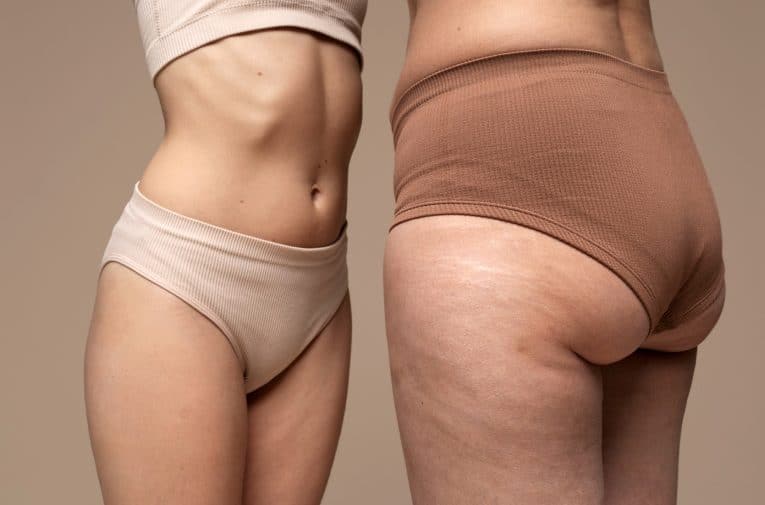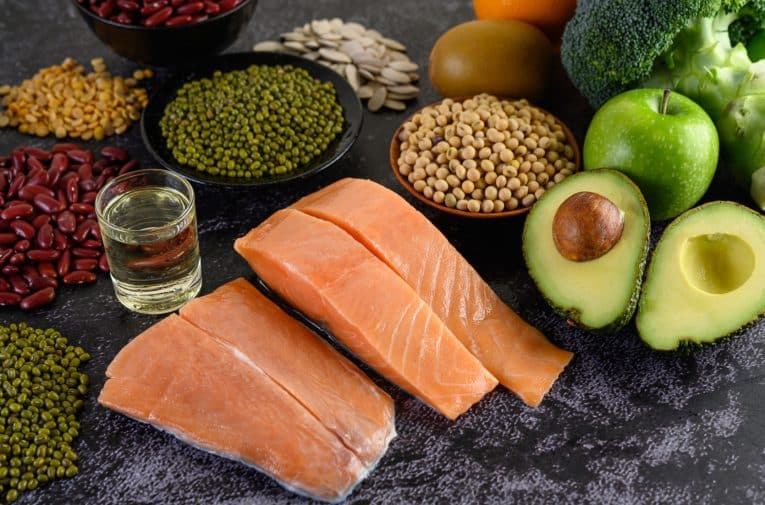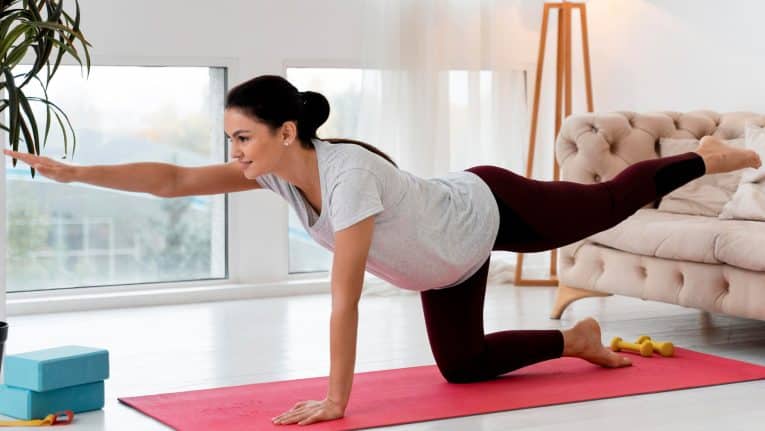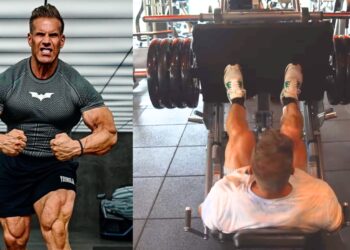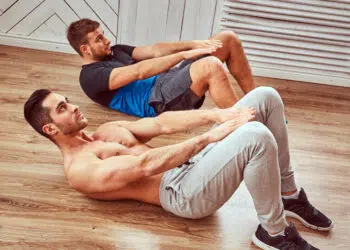The term “saddlebags” describes excess fat deposits on a woman’s outer thighs. It is a common cosmetic concern for many women and can be difficult to eliminate through diet and exercise alone. Fat accumulation in this area is often a result of genetics and hormonal factors and can be influenced by factors such as age, weight, and lifestyle. 4,370
While there are no specific exercises to target saddlebags, a combination of cardiovascular exercise, strength training, and a balanced diet can help reduce fat and improve body shape.
In this article, we’ll lay out a complete plan to tackle saddlebags, allowing you to sculpt lean, athletic legs.
What Causes Saddlebags?
Saddlebags are a common site for fat accumulation in women, and several factors can contribute to the fat buildup in the region:
- Genetics: Some people have a genetic predisposition to store fat in certain body areas, including the hips, thighs, and buttocks. [1]
- Hormonal changes: Hormonal imbalances, such as those that occur during menopause or with hormonal birth control, can cause fat accumulation in the hips, thighs, and buttocks. [2]
- Age: As we age, the distribution of fat in our bodies tends to shift, with more fat building up in the hips, thighs, and buttocks. [3]
- Sedentary lifestyle: Lack of physical activity can lead to overall weight gain and fat accumulation, including in the saddlebag area. [4]
- Poor diet: Consuming excessive high-calorie, high-fat, and processed foods can lead to weight gain and fat accumulation. [5]
Can You Spot Reduce Saddlebags?
Spot reduction refers to losing fat in specific body areas. It is impossible because fat loss occurs in a generalized way all over your body, and you cannot control where your body burns fat first. The best way to reduce body fat is through a healthy diet and regular physical activity that promotes overall calorie deficit. [6]
Level Up Your Fitness: Join our 💪 strong community in Fitness Volt Newsletter. Get daily inspiration, expert-backed workouts, nutrition tips, the latest in strength sports, and the support you need to reach your goals. Subscribe for free!
So, you cannot just do exercises for your outer thighs and expect to get rid of your saddlebags.
A combination of cardiovascular exercise, strength training, and a balanced diet is needed to reduce overall body fat, including in the saddlebag area. Cardiovascular exercises, such as running, cycling, or swimming, help burn calories and increase heart rate, which can lead to fat loss.
Strength training can help build muscle and increase metabolism, which can also aid in fat loss. Exercises that target the hips, thighs, and buttocks, such as squats, lunges, and deadlifts, can help tone and strengthen these muscles, giving them a firmer, more toned appearance.
How to Eat to Get Rid of Saddlebags
To get rid of saddlebags, you need to focus on overall weight loss through a calorie deficit, which you can achieve by combining a healthy diet with regular physical activity.
Here are some general guidelines for eating to support weight loss:
- Focus on nutrient-dense foods: Eating a diet rich in fruits, vegetables, whole grains, and lean proteins can help you feel full and satisfied while reducing your overall calorie intake.
- Limit processed and high-calorie foods: Foods high in added sugars, saturated and trans fats, and sodium can add extra calories to your diet and promote weight gain.
- Stay hydrated: Drinking enough water can help maintain healthy body weight and support weight loss efforts.
- Control portion sizes: Eating smaller, more frequent meals can help you avoid overeating and maintain a calorie deficit.
- Limit alcohol intake: Alcohol is high in calories and can contribute to weight gain.
It’s important to note that everyone’s calorie needs and ideal diet are different and may require individualized recommendations. Consulting a healthcare professional or registered dietitian can help you determine the best approach for your needs and goals.
Establishing a Caloric Deficit
A calorie deficit is important for weight loss because it includes consuming fewer calories than your body burns. To establish a calorie deficit, you can either reduce your calorie intake, increase physical activity, or a combination of both.
Here are a few tips for establishing a calorie deficit:
- Track your calorie intake: Keeping track of the foods you eat and the calories they contain can help you understand how many calories you’re consuming and identify areas for improvement.
- Reduce portion sizes: Eating smaller portions can help reduce your calorie intake without feeling deprived.
- Choose nutrient-dense foods: Eating foods that are high in nutrients and low in calories can help you feel full and satisfied with fewer calories.
- Increase physical activity: Regular physical activity can help burn calories and increase energy expenditure, leading to a calorie deficit.
- Limit calorie-dense foods and drinks: Foods and drinks high in added sugars, fats, and alcohol can contribute many calories to your diet and make it harder to establish a calorie deficit.
It’s important to remember that weight loss should be gradual, with a recommended rate of 1-2 pounds per week. Rapid weight loss or crash dieting can be harmful and is not sustainable in the long term. Consulting a healthcare professional or registered dietitian can help you determine the best approach for your needs and goals.
Related: Calorie Deficit Calculator
Can You Spot Reduce Saddlebag?
No, you cannot spot-reduce weight in a specific body area, including saddlebags. The body burns fat from all over, not just from one specific area, and where you tend to store fat is primarily determined by genetics.
While targeted exercises can help strengthen and tone the muscles in the hips, thighs, and buttocks, they will not specifically target fat loss in that area. The best way to reduce saddlebags is to create an overall calorie deficit through a healthy diet and regular exercise, including cardiovascular and strength training. It will help burn calories, increase metabolism, and reduce overall body fat, including in the saddlebag area.
How Important Are Genetics When it Comes to Fat Distribution?
Genetics play a significant role in fat storage. The specific genes involved in fat metabolism and storage are complex and are not fully understood, but research has shown that genetic factors can influence where and how the body stores fat.
For example, some women may have a genetic predisposition to store fat in their hips and thighs, while others may store more fat in their abdominal area. These differences in fat distribution can influence overall health and the risk of developing certain conditions, such as metabolic syndrome and heart disease.
It’s important to note that genetics is just one of many factors that contribute to fat storage and distribution. Other factors such as diet, physical activity, and hormonal imbalances can also play a role. While you may have a genetic predisposition to store fat in certain areas, making lifestyle changes can help reduce overall body fat and improve overall health.
Does Estrogen Cause Saddlebag Weight Gain in Women?
Estrogen can play a role in saddlebag weight gain in women, as it can influence the distribution of fat in the body. Hormonal changes, such as those that occur during menopause, can lead to a shift in fat storage from the hips and thighs to the abdominal area, including the saddlebag area.
The impact of estrogen on saddlebag weight gain can differ from woman to woman.
Does Pregnancy Contribute to Saddlebags?
Yes, pregnancy can contribute to the development of saddlebags. During pregnancy, the body experiences significant hormonal changes and weight gain, which can lead to fat accumulation in certain areas, including the outer thighs. Additionally, pregnancy can also cause the skin and connective tissue to stretch, leading to a dimpled appearance.
After pregnancy, the body can take time to return to its pre-pregnancy state, and the fat deposits in the outer thighs may persist. However, diet and exercise can help reduce overall body fat and improve overall body composition, which can reduce the appearance of saddlebags. It’s important to consult a doctor before starting any new exercise or diet program, especially if you have recently given birth.
Does Puberty Make Saddlebag Fat Worse?
Puberty can contribute to changes in body shape and fat distribution, which may make saddlebag fat more noticeable. During puberty, the body experiences hormonal changes that can cause an increase in body fat and an overall shift in body composition. It can result in fat accumulation in certain areas, including the hips and outer thighs, leading to saddlebag development.
Additionally, during puberty, the body undergoes significant growth and development, which can cause the skin and connective tissue to stretch. This can result in a dimpled appearance, commonly referred to as cellulite.
Level Up Your Fitness: Join our 💪 strong community in Fitness Volt Newsletter. Get daily inspiration, expert-backed workouts, nutrition tips, the latest in strength sports, and the support you need to reach your goals. Subscribe for free!
What is the Best Type of Cardio to Get Rid of Saddlebags?
There is no one best type of cardio for getting rid of saddlebags, as the effectiveness of an exercise for weight loss depends on many factors such as frequency, intensity, duration, and individual differences.
Various cardiovascular exercises can help burn calories and support weight loss. Here are a few examples:
- Running: Running is a high-intensity cardiovascular exercise that can help you burn a significant number of calories in a short amount of time.
- Cycling: Cycling can be a low-impact option to help burn calories and improve cardiovascular fitness.
- HIIT (High-Intensity Interval Training): HIIT is a form of cardiovascular exercise that alternates high-intensity exercise periods with rest. It can be an effective way to burn calories and improve cardiovascular fitness.
- Swimming: Swimming is a full-body exercise that can effectively burn calories and improve cardiovascular fitness.
Will Building My Thigh Muscles Help Get Rid of Saddlebags?
Building your thigh muscles can help improve the appearance of saddlebags, but it will not necessarily get rid of them.
While strength training can help increase muscle mass and shape your legs, it will not necessarily cause you to lose fat in specific areas, as fat loss occurs in a generalized way all over your body.
What Are the Main Muscles Around Saddlebag Fat?
The main muscles around saddlebag fat are the gluteus maximus, gluteus medius, and gluteus minimus. These muscles are collectively known as the glutes and are responsible for hip extension, abduction, and rotation.
In addition to the glutes, the quadriceps, hamstrings, and inner and outer thigh muscles (adductors and abductors) also help shape the appearance of the thighs and hips. Building strength and tone in these muscle groups can help improve the area’s overall appearance and enhance your body shape.
How Do You Get Rid of Cellulite on the Outer Thighs
Cellulite is the dimpled appearance of skin that occurs due to fat accumulation in underlying connective tissue. To reduce the appearance of cellulite on the outer thighs, you can try the following methods:
- Exercise: Combining strength training exercises that target the muscles in the legs and hips with cardiovascular exercise can help improve overall body composition and reduce the appearance of cellulite.
- Diet: Maintaining a balanced, calorie-controlled diet can help reduce body fat and improve overall body composition.
- Massage: Massaging the affected areas can help improve circulation and reduce the appearance of cellulite.
- Topical treatments: Topical treatments containing caffeine and retinol, such as creams and gels, have been shown to smooth the skin’s surface temporarily.
- Liposuction: Liposuction is a surgical procedure that removes fat from specific body areas.
It’s important to note that cellulite is a normal part of aging and affects most women at some point. While no single solution completely eliminates cellulite, a healthy diet and exercise routine can help reduce its appearance.
How Can I Hide My Saddlebag Thighs?
If you want to hide your saddlebags, you can try the following:
- Clothing: Wear clothing that helps conceal the area, such as A-line skirts, loose pants, or high-waisted pants with wider legs. Avoid tight-fitting clothing that accentuates the area.
- Shapewear: Shapewear, such as high-waisted control pants, can help smooth and contour the appearance of the thighs.
- Accessories: Wearing a long scarf or shawl can help draw attention away from the saddlebags and towards the upper body.
- Posture: Good posture can help elongate the appearance of the legs and make saddlebags appear less noticeable.
Hiding saddlebags is only a temporary solution. A healthy diet and exercise routine can reduce their appearance over time. Additionally, it’s important to be comfortable and confident in your skin and not feel ashamed or embarrassed about your appearance. Embracing and loving your body is a key aspect of self-care and self-love.
9 Best Exercises to Get Rid of Outer Thigh Saddlebags
Here are the nine best saddlebag exercises to add to your training regimen:
1. Dumbbell Squat
The dumbbell squat allows you to load your lower body without compressing your spine. This exercise is safer than the barbell back squat. Drop the dumbbells if you fail during a rep.
Steps:
- Stand with your feet shoulder-width apart, with your hands at your sides.
- Grab a dumbbell in each hand with a neutral grip.
- Lower yourself into a squat until your quads are parallel to the floor. Maintain a natural arch in your lower back.
- Driving through your heels, return to the start position.
- To maintain tension in the quads, halt short of lockout at the top.
- Repeat.
Benefits of the dumbbell squat:
- Loads the quads without spinal compression
- Safer than the barbell squat
This Exercise:
- Target Muscle Group: Quadriceps
- Secondary Muscles: Glutes and Hamstrings
- Type: Strength
- Mechanics: Compound
- Equipment: Dumbbells
- Difficulty: Intermediate
- Best Rep Range:
- Hypertrophy: 8-12
- Strength: 1-5
2. Bulgarian Split Squat
The Bulgarian Split Squat allows you to load your quads one leg at a time. This exercise will also improve your coordination and balance.
Steps:
- Stand about two feet in front of a bench.
- Place the top of your right foot on the bench.
- Hold a pair of dumbbells at your sides. Your rear leg should be slightly bent.
- Lower toward the floor by bending at your knees. The rear knee should be a few inches off the floor at the bottom.
- Push through the front heel to return to the start position.
Benefits of the Bulgarian split squat:
- The unilateral leg exercise fixes muscle and strength imbalances
- Improves balance and coordination
This Exercise:
- Target Muscle Group: Quadriceps
- Secondary Muscles: Glutes and Hamstrings
- Type: Strength
- Mechanics: Compound
- Equipment: Dumbbells
- Difficulty: Intermediate
- Best Rep Range:
- Hypertrophy: 8-12
- Strength: 1-5
3. Cable Squat
The cable squat is a squat variation that allows you to load the quads without compressing the spine. This exercise also allows you to vary the angle of resistance so that it aligns with the direction of the muscle fibers.
Steps:
- Stand in front of a cable pulley machine and set it at its lowest setting.
- Grab the straight handlebar with an overhand grip and stand about three feet away from the pulley, facing it.
- Lower yourself by pushing your hips back and down until your quads are parallel to the floor.
- Push through your heels to return to the start position.
Benefits of the cable squat:
- Eliminates spinal load
- The direction of resistance matches the muscle fiber direction
This Exercise:
- Target Muscle Group: Quadriceps
- Secondary Muscles: Glutes, hamstrings
- Type: Strength
- Mechanics: Compound
- Equipment: Cable machine
- Difficulty: Intermediate
- Best Rep Range:
- Hypertrophy: 8-12
- Strength: 1-5
4. Dumbbell Lunge
The dumbbell lunge is a functional exercise that works the quads, glutes, and hamstrings. This unilateral exercise allows you to focus on each limb separately.
Steps:
- Stand with your feet shoulder-width apart and a pair of dumbbells held at arm’s length.
- Take a giant step forward with your left foot.
- Lower into a lunge while maintaining an upright torso. Bring your rear knee down to about an inch off the floor.
- Push through the front heel to return to the start position.
Benefits of the dumbbell lunge:
- Unilateral exercise for even strength and muscle development
This Exercise:
- Target Muscle Group: Quadriceps
- Secondary Muscles: Glutes and Hamstrings
- Type: Strength
- Mechanics: Compound
- Equipment: Dumbbells
- Difficulty: Intermediate
- Best Rep Range:
- Hypertrophy: 8-12
- Strength: 1-5
5. Resistance Band Squat
The resistance band squat is a great squat variation to do at home.
Steps:
- Stand with your feet shoulder-width apart.
- Loop a resistance band under your mid feet and hold the other ends in your hands at shoulder width.
- Lower yourself by pushing your hips back and down.
- Your quads should be at least parallel to the floor at the bottom.
- Drive through your heels to return to the start position.
Benefits of the resistance band squat:
- It is a safe, low-cost squat variation
This Exercise:
- Target Muscle Group: Quadriceps
- Secondary Muscles: Glutes and Hamstrings
- Type: Strength
- Mechanics: Compound
- Equipment: Resistance band
- Difficulty: Intermediate
- Best Rep Range:
- Hypertrophy: 8-12
- Strength: 1-5
6. Leg Extension
The leg extension isolates your quadriceps through their full range of motion. It produces an intense quad burn, promoting hypertrophy and strength increase.
Steps:
- Sit on a leg extension machine and select the appropriate weight. Place your feet under the ankle pads and lean back on the seat. Grab the handles.
- Extend your knees to straighten your legs. Stop just short of lockout.
- Lower back down, stopping just short of the start position.
Benefits of the leg extension:
- Isolates the quads
- No spinal compression
This Exercise:
- Target Muscle Group: Quadriceps
- Type: Strength
- Mechanics: Compound
- Equipment: Leg extension machine
- Difficulty: Intermediate
- Best Rep Range:
- Hypertrophy: 8-12
- Strength: 1-5
7. Glute Bridge
The glute bridge is an effective bodyweight exercise for strengthening the glutes and increasing core stability.
Steps:
- Lie on the floor on your back with your knees bent and arms on the floor at your sides. Your knees should be hip-width apart.
- Contract your core and press your heels into the floor as you lift your hips into the air. Go up until a straight line forms from your shoulders to your knees.
- Contract your glutes strongly in the top position.
- Hold for three seconds.
- Lower under control and repeat.
Benefits of the glute bridge:
- Strengthens the glutes with no equipment
- Stabilizes the core
This Exercise:
- Target Muscle Group: glutes
- Secondary Muscles: Abdominals
- Type: Strength
- Mechanics: Compound
- Equipment: None
- Difficulty: Intermediate
- Best Rep Range:
- Hypertrophy: 10-20
- Strength: 1-5
8. Donkey Kickback
The donkey kickback is another glute strengthener you can do without any equipment. At the same time, this exercise strengthens and stabilizes the core.
Steps:
- Get down on all fours with your hands directly under your shoulders. Your knees should be directly under your hips. Maintain a neutral spine with a flat back and tuck your chin in.
- Contract your core and, without straightening the knee, kick your right leg back and up behind you. The only movement should come from the hip joint. Stop when the right leg forms a straight line with your torso.
- Return to the start position and repeat. Do all reps on the right leg and then repeat on the left leg.
Benefits of the donkey kickback:
- Strengthens the glutes without equipment
- Stabilizes the core
This Exercise:
- Target Muscle Group: Glutes
- Secondary Muscles: Abdominals
- Type: Strength
- Mechanics: Isolation
- Equipment: None
- Difficulty: Intermediate
- Best Rep Range:
- Hypertrophy: 10-20
- Strength: 1-5
9. Cable Kickback
The cable kickback does a similar job to the donkey kick, with the added benefit of adding resistance beyond your body weight. That allows you to increase the weight, so your glutes keep getting stronger progressively.
Steps:
- Put an ankle strap on a cable pulley machine’s cable and set it at its lowest position. Set the appropriate weight.
- Face the machine and attach the ankle strap to your right ankle. Grab the machine’s frame with your right hand for support.
- Lean slightly forward as you kick the right leg back and up. Do not bend your knee; the movement should originate at the hip joint.
- Lower under control and repeat. Do all reps with one leg and then repeat on the other side.
Benefits of the cable kickback:
- Strengthens the glutes
- Isolates each leg separately
This Exercise:
- Target Muscle Group: Glutes
- Secondary Muscles: Abdominals
- Type: Strength
- Mechanics: Isolation
- Equipment: Cable machine
- Difficulty: Intermediate
- Best Rep Range:
- Hypertrophy: 10-20
- Strength: 1-5
FAQs
Do Lower Back Problems Contribute to Saddlebag Fat?
Lower back problems may not directly contribute to saddlebag fat, but they can affect posture and body mechanics, leading to changes in fat distribution in the body. Poor posture and body mechanics can lead to muscle imbalances, causing the body to compensate in ways that affect fat distribution. Additionally, some lower back problems can cause pain and discomfort that can limit physical activity, decreasing muscle mass and increasing body fat.
Maintaining good posture and proper body mechanics can help reduce the risk of lower back problems and promote overall health and wellness. If you are experiencing lower back pain, you must consult a doctor or physical therapist for a proper diagnosis and treatment plan. Improving posture and reducing muscle imbalances through strength training and exercise can help reduce the appearance of saddlebags and improve overall body composition.
How Much Does it Cost for Liposuction to Remove Saddlebags?
The cost of liposuction to remove saddlebags varies depending on several factors, including the surgeon’s experience and location, the amount of fat to be removed, and the specific techniques used. On average, the cost of liposuction can range from $2,000 to $10,000 or more.
It’s important to keep in mind that liposuction is a surgical procedure and carries risks and potential complications, such as infection, scarring, and changes in skin sensation. Additionally, liposuction does not address the underlying causes of fat accumulation and does not guarantee long-term results. It’s important to consult a board-certified plastic surgeon to discuss liposuction’s risks, benefits, and costs and determine if it is the right option for you.
Can I Lose Saddlebags Without Exercise?
While it is possible to lose weight without exercise, exercise is an important part of a healthy lifestyle. It can help improve overall body composition, including reducing the appearance of saddlebags. Regular physical activity can help increase muscle mass, boost metabolism, and reduce body fat, reducing the appearance of saddlebags.
A healthy diet can also play a role in reducing saddlebags. A diet rich in nutrient-dense foods, such as fruits and vegetables, lean protein, and whole grains, can help control weight and promote overall body health. Limiting processed and high-calorie foods and drinks can also help reduce the risk of weight gain and improve overall body composition.
Summary
Saddlebag is a colloquial term for excess fat deposits on the outer thighs. A combination of diet and exercise is recommended to get rid of saddlebags. You can focus on strength training exercises that target the muscles in the legs and hips and cardiovascular exercises to burn fat.
Maintaining a balanced, calorie-controlled diet and staying hydrated can also help reduce body fat and improve overall body composition. It’s important to remember that spot reduction, targeting fat loss in a specific area, is impossible. Rather, overall weight loss through a combination of diet and exercise can reduce fat deposits in all areas of the body, including the outer thighs.
References:
- Schleinitz D, Böttcher Y, Blüher M, Kovacs P. The genetics of fat distribution. Diabetologia. 2014 Jul;57(7):1276-86. doi: 10.1007/s00125-014-3214-z. Epub 2014 Mar 16. PMID: 24632736.
- Davis SR, Castelo-Branco C, Chedraui P, Lumsden MA, Nappi RE, Shah D, Villaseca P; Writing Group of the International Menopause Society for World Menopause Day 2012. Understanding weight gain at menopause. Climacteric. 2012 Oct;15(5):419-29. doi: 10.3109/13697137.2012.707385. PMID: 22978257.
- Tchkonia T, Morbeck DE, Von Zglinicki T, Van Deursen J, Lustgarten J, Scrable H, Khosla S, Jensen MD, Kirkland JL. Fat tissue, aging, and cellular senescence. Aging Cell. 2010 Oct;9(5):667-84. doi: 10.1111/j.1474-9726.2010.00608.x. Epub 2010 Aug 15. PMID: 20701600; PMCID: PMC2941545.
- Lavie CJ, Ozemek C, Carbone S, Katzmarzyk PT, Blair SN. Sedentary Behavior, Exercise, and Cardiovascular Health. Circ Res. 2019 Mar;124(5):799-815. doi: 10.1161/CIRCRESAHA.118.312669. PMID: 30817262.
- Swinburn BA, Kraak VI, Allender S, Atkins VJ, Baker PI, Bogard JR, Brinsden H, Calvillo A, De Schutter O, Devarajan R, Ezzati M, Friel S, Goenka S, Hammond RA, Hastings G, Hawkes C, Herrero M, Hovmand PS, Howden M, Jaacks LM, Kapetanaki AB, Kasman M, Kuhnlein HV, Kumanyika SK, Larijani B, Lobstein T, Long MW, Matsudo VKR, Mills SDH, Morgan G, Morshed A, Nece PM, Pan A, Patterson DW, Sacks G, Shekar M, Simmons GL, Smit W, Tootee A, Vandevijvere S, Waterlander WE, Wolfenden L, Dietz WH. The Global Syndemic of Obesity, Undernutrition, and Climate Change: The Lancet Commission report. Lancet. 2019 Feb 23;393(10173):791-846. doi: 10.1016/S0140-6736(18)32822-8. Epub 2019 Jan 27. Erratum in: Lancet. 2019 Feb 23;393(10173):746. PMID: 30700377.
- Paoli A, Casolo A, Saoncella M, Bertaggia C, Fantin M, Bianco A, Marcolin G, Moro T. Effect of an Endurance and Strength Mixed Circuit Training on Regional Fat Thickness: The Quest for the “Spot Reduction”. Int J Environ Res Public Health. 2021 Apr 6;18(7):3845. doi: 10.3390/ijerph18073845. PMID: 33917584; PMCID: PMC8038840.
Interested in measuring your progress? Check out our strength standards for Bulgarian Split Squat, Dumbbell Lunge, Deadlift, and more.

